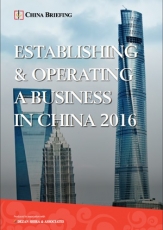China’s Wastewater Treatment Industry: Opportunities for Foreign Investors
By Jake Liddle
In recent years, China has increased its focus and efforts towards combating the high levels of environmental pollution in the country, the result of its accelerated economic growth. In 2012, China declared war on pollution, and put aside RMB 3.7 trillion for the battle, with over half of the funds reserved for water pollution. The 13th Five Year Plan targets this issue, and in 2015, the government published the Water Pollution Prevention and Control Action Plan, aiming to halt heavily polluting sectors from contaminating water sources.
However, China’s most recent environmental report remains negative, suggesting that 61.5 percent of groundwater and 28.8 percent of key rivers were classed as ‘not suitable for human contact’. The contamination is largely caused by industrial and agricultural industries, and the resulting pollution has permeated the earth down to the water table. The report found that usable and safe water is scarce, and over half of China’s cities suffer from water shortages, especially in the arid northern regions. While China has 20 percent of the world’s population, it only possesses seven percent of the world’s water resources. What’s more, these water resources are not reliable and are distributed unevenly among provinces and administrative regions.
For China to reverse the state of its severe water pollution, high-grade wastewater treatment technologies are in great demand.
China’s existing wastewater treatment facilities
China has developed multiple technologies to treat wastewater, and now has the world’s second-highest sewerage processing capacity, with around 3,340 wastewater treatment plants as of 2012. 80 percent of these plants use the following three technologies and remove contaminants from sewerage:
- Oxidization ditches: A modified activated sludge biological treatment process utilizing long solids retention times to remove biodegradable organic matter. Used in both municipal and industrial wastewater treatment;
- Anaerobic Anoxic OXic (ANANOX) process: A patented low energy, biological denitrification process utilizing anaerobic pre-treatment and settler chamber; and,
- Sequencing batch reactors: Oxidizes wastewater or sewerage from anaerobic digesters or mechanical biological treatment facilities in batches, with aeration and sludge settlement occurring at the same time in one tank.
China also utilizes ‘constructed wetlands’ as an alternative ecological method of treating wastewater, and addressing runoff issues and flood water retention. Constructed wetlands are man-made biological environments combining hydrology, vegetation and flow paths which provide effective means of treating biochemical oxygen demand, soluble solids, nitrogen, phosphorus, heavy metals, organic pollutants and pathogens. They can be constructed and customized by either biotic or abiotic mechanisms to target certain types of occurring pollutants depending on locational needs. Constructed wetland systems are the cheapest method of wastewater treatment, requiring about 30 to 50 percent of the cost of conventional treatment methods.
![]() RELATED: Pre-Investment and Entry Strategy Advisory from Dezan Shira & Associates
RELATED: Pre-Investment and Entry Strategy Advisory from Dezan Shira & Associates
Moreover, China’s rural regions suffer the most from water shortages and water pollution. Rural distribution of wastewater treatment is extremely poor. Only 3 percent of villages and townships possess wastewater treatment facilities, and more than 90 percent lack proper drainage and sewerage facilities. 300 million rural residents do not have access to safe drinking water. Thus, rural areas are in the most need of effective and economical treatment facilities. Due to the lack of infrastructure, dispersed population and geographical issues, smaller decentralized facilities would be the most effective application.
Opportunities for investors
Foreign investors can bring experience and new technologies to China, where national sentiment attaches great importance to the sanitation of water for both municipal use and for the greater environment. The Chinese government is expected to spend an additional RMB 4 trillion to improve water infrastructure and household supply. Its keen support for this effort means that, apart from matters concerning water conservancy, environment and public facility management, foreign investment into the country’s waste water treatment technology is desperately needed and endorsed by the Catalogue of Industries for Guiding Foreign Investment.
On top of treatment technologies, water infrastructure is another key aspect of the industry. Innovative urban water design and energy-efficient water saving technologies, secondary water supply systems, smart water systems, environmentally friendly rainwater collecting, water purification, municipal pipe networks and water reclamation technology are auxiliary components that are also open for foreign investment.
Key takeaways
Rural areas are in the most need of simple, low-cost and decentralized treatment facilities in order to effectively provide sustainable sanitary water sources. Additionally, with environmentally friendly and sustainable projects foregrounded in the state’s development strategy, constructed wetlands provide a cost-effective means to tackle water shortage and pollution in an ecological way.
|
Asia Briefing Ltd. is a subsidiary of Dezan Shira & Associates. Dezan Shira is a specialist foreign direct investment practice, providing corporate establishment, business advisory, tax advisory and compliance, accounting, payroll, due diligence and financial review services to multinationals investing in China, Hong Kong, India, Vietnam, Singapore and the rest of ASEAN. For further information, please email china@dezshira.com or visit www.dezshira.com. Stay up to date with the latest business and investment trends in Asia by subscribing to our complimentary update service featuring news, commentary and regulatory insight.
|

 An Introduction to Doing Business in China 2016
An Introduction to Doing Business in China 2016
Doing Business in China 2016 is designed to introduce the fundamentals of investing in China. Compiled by the professionals at Dezan Shira & Associates in June 2016, this comprehensive guide is ideal not only for businesses looking to enter the Chinese market, but also for companies who already have a presence here and want to keep up-to-date with the most recent and relevant policy changes
 Establishing & Operating a Business in China 2016
Establishing & Operating a Business in China 2016
Establishing & Operating a Business in China 2016, produced in collaboration with the experts at Dezan Shira & Associates, explores the establishment procedures and related considerations of the Representative Office (RO), and two types of Limited Liability Companies: the Wholly Foreign-owned Enterprise (WFOE) and the Sino-foreign Joint Venture (JV). The guide also includes issues specific to Hong Kong and Singapore holding companies, and details how foreign investors can close a foreign-invested enterprise smoothly in China.
 Tax, Accounting, and Audit in China 2016
Tax, Accounting, and Audit in China 2016
This edition of Tax, Accounting, and Audit in China, updated for 2016, offers a comprehensive overview of the major taxes that foreign investors are likely to encounter when establishing or operating a business in China, as well as other tax-relevant obligations. This concise, detailed, yet pragmatic guide is ideal for CFOs, compliance officers and heads of accounting who must navigate the complex tax and accounting landscape in China in order to effectively manage and strategically plan their China-based operations.
- Previous Article Understanding China’s VAT Accounting Guidelines
- Next Article China-Mongolia Relations: Challenges and Opportunities








